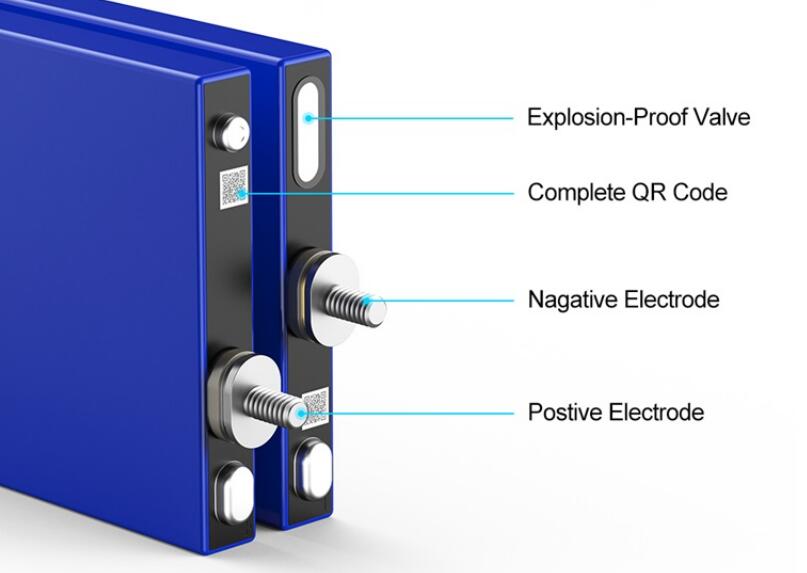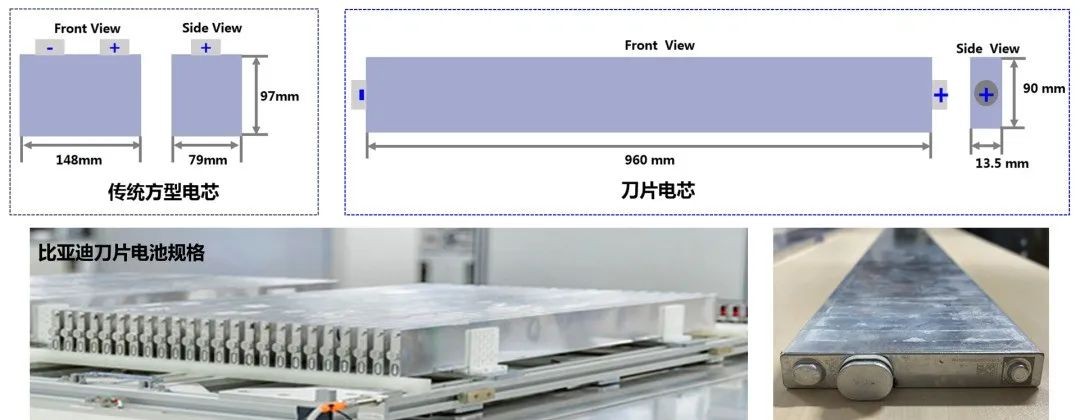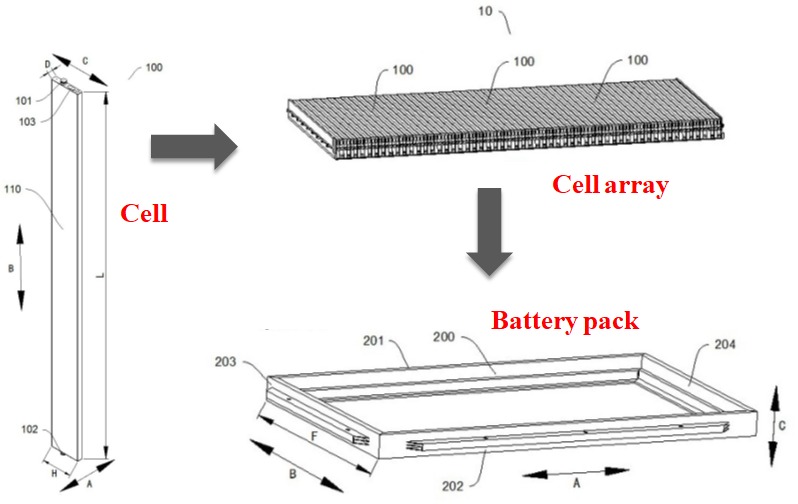BYD BLADE BATTERY Cell

BYD BLADE BATTERY Cell
The Blade Battery has been developed by BYD over the past several years. The singular cells are arranged together in an array and then inserted into a battery pack. Due to its optimized battery pack structure, the space utilization of the battery pack is increased by over 50% compared to conventional lithium iron phosphate block batteries.
While undergoing nail penetration tests, the Blade Battery emitted neither smoke nor fire after being penetrated, and its surface temperature only reached 30 to 60°C. Under the same conditions, a ternary lithium battery exceeded 500°C and violently burned, and while a conventional lithium iron phosphate block battery did not openly emit flames or smoke, its surface temperature reached dangerous temperatures of 200 to 400°C. This implies that EVs equipped with the Blade Battery would be far less susceptible to catching fire – even when they are severely damaged.
The Blade Battery also passed other extreme test conditions, such as being crushed, bent, being heated in a furnace to 300°C and overcharged by 260%. None of these resulted in a fire or explosion.
He Long, Vice President of BYD and Chairman of FinDreams Battery Co., Ltd., covered four distinct advantages of the Blade Battery including a high starting temperature for exothermic reactions, slow heat release and low heat generation, as well as its ability to not release oxygen during breakdowns or easily catch fire.
In the past few years, many EV manufacturers have fallen into a competition for ever-greater cruising range. When the range becomes the prime factor to consider, this focus is then transferred to power battery makers, leading to unreasonable pursuits of “energy density” in the battery industry. It is due to this unpractical focus on “energy density” that safety has been sidelined from power battery development. BYD’s Blade Battery aims to bring battery safety back to the forefront, a redirection from the industry’s tenuous focus on this crucial aspect.
How safe is the BYD Blade Cell?
Ultra Safe - Succesfully passed the "Mt Everest" nail penetration test*.
Ultra Strength - Succesfully passed the extreme strength test of 46-ton truck rolling over it*.
Ultra Long Range - Allows a range capacity exceeding 1,000km together with e-Platform 3.0*.
Ultra-long Lifespan - Supports a long battery life with over 3000 charge and discharge cycles.
Super Power - Only 10min needed charging from 10%-80%, meeting the requirement of most fast charging scenarios*. Max. peak power provides 2.9s acceleration from 0-100km/h*.
Nail Penetration Test
Launched by BYD in 2020, Blade Battery is the only battery that successfully passes the nail penetration test, the most rigorous way to test the thermal runaway of batteries. While undergoing nail penetration tests, Blade Battery emits neither smoke nor fire after being penetrated, and its surface temperature only reaches 30 to 60 ° C. Under the same conditions, a ternary lithium battery mostly exceeds 500 ° C and violently burns, and while a conventional lithium iron phosphate block battery does not openly emit flames or smoke, its surface temperature reaches dangerous temperatures of 200 to 400 ° C. That means Blade Battery is ultra-safe.
Blade Battery Truck Drive Over Test
BYD Batteries have a 10-year track record and millions of on-road miles. That means BYD batteries are built to last up to 30 years of life, 20 to 25 years of warranty on eligible storage projects.
Remark:
LFP battery: Lithium iron phosphate battery
NCM battery: Lithium Nickel Manganese Cobalt Oxide battery
*T&C Apply
*In standard conditions.
*The illustration of Blade Battery and e-Platform 3.0 is for the purpose of presenting the capability of the Blade Battery only, whose details may vary on different models.
*All features/specifications are not available in all varients and may vary for different varients.
*Specifications/features are subject to change without prior information.
More about BYD Blade Cell - Redefining EV Safety Standards
BYD Blade battery is made of lithium iron phosphate as cathode material; Excellent safety features and long cycle life; Good temperature performance, wide operating temperature range, high energy density, and is environment friendly.


Whether powering your home or business, the BYD LiFePO4 Blade Battery 3.2V 138Ah is an excellent choice for reliable energy that lasts, giving you greater peace of mind knowing your system isn't going to quit at the worst possible time.
Item | Parameters |
Nominal Voltage | 3.2V |
Nominal Capacity | 138Ah (have different capacity options) |
Charging Method | CC |
Charge Current | Standard charging current: 0.2C |
Max. continuous charging current: 1.5C@ 23℃ |
Charging cut-off voltage | 3.8V |
Discharge Current | Standard discharging current: 0.2C |
Max. discharging current: 2C |
Discharging cut-off voltage | 2.0V |
DCIR@50%SOC | 30s, 1.5C, 3.0±0.2mΩ |
Working Temperature | Charge: -10~+50℃, Discharge: -20~+55℃ |
Storage Temperature | -10~30℃ (<1year, SOC: 30%~60%) |
Shipping Status | Voltage: 2.5-4.35V, SOC:25%~50% |
Cycle Life | ≥4000 times |
Size | 960(L)*13.5(T)*90(W)mm |
Weight | 2.63 ± 0.1Kg |
The BYD blade battery is essentially a square hard-shell battery designed with a thin and long form factor. The external dimensions are approximately 960.0±10 mm × 90.0±1.0 mm × 13.5+2.5/-1.5 mm. The dimensions may vary slightly depending on the specific model, for example, the thickness of the blade battery for the 138Ah specification is approximately 12mm, while the thickness of the blade battery for the 202Ah specification is approximately 13.5mm.
The blade batteries are arranged with honeycomb aluminum plates, with two high-strength aluminum plates attached to the top and bottom, allowing for higher space utilization and the ability to fit more battery cells in the same space compared to traditional modules.

When assembling the battery pack with BYD blade batteries, the strength of the blade batteries themselves is utilized to reduce the size of crossbeams and other components in the battery pack. As a result, the module form of the battery pack undergoes significant deformation under random vibrational loads, while the deformation of the blade battery cells is minimal.
Cell-to-Pack Technology
With CTP technology, battery packs are assembled directly from the cells without the need for modules. Many battery manufacturers, such as BYD Auto, CATL, LG Chem, and SVOLT, are exploring CTP technology. The Blade Battery is BYD’s realization of the CTP concept (Figure 1).

Figure 1. The structure of the Blade Battery from cell to pack.
BYD Blade Battery-Inspired by CTP Geometry
At the center of the design of the Blade Battery is the cell geometry, which has a much lower aspect ratio compared with conventional cylindrical or prismatic cells. According to BYD’s patents, the cell depth (Z axis) is 13.5 mm while the cell length (X axis) can range from 600 mm to 2500 mm. The inactive parts of the cell, including the lug, pole, and busbar , are all aligned with the X axis. For most EV cells, space in the Z direction is at a premium because of the limited room under passenger seats (Figure 2). The ultra-long X axis mitigates the volume lost to the inactive parts. In the CTP process, each cell is connected in series or parallel aligned with the X axis. The large surface area can increase the thermal dissipation of the cells.

Figure 2. Schematics of honey-combed structural panels for battery pack.
Relevant Products